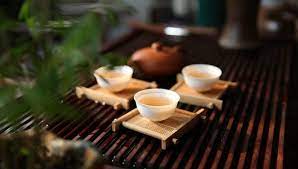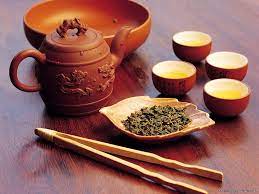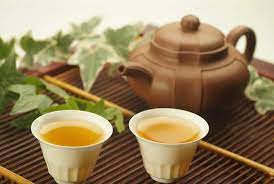The origin and meaning of Chinese tea culture

When Chinese people drink tea, they pay attention to the word "product". "Tasting tea" not only identifies the quality of tea, but also has the meaning of reverie and appreciation of tea drinking. Make a pot of strong tea in the middle of your busy schedule, choose an elegant and quiet place, and drink it by yourself, which can eliminate fatigue, relieve troubles, improve your mind, and invigorate your spirit. High art realm. The environment for tea tasting is generally composed of buildings, gardens, furnishings, tea sets and other factors. Tea drinking requires quietness, freshness, comfort and cleanliness. Chinese gardens are famous all over the world, and the landscapes are even more numerous. Make use of gardens or natural landscapes, use wood to make pavilions, stools, and set up tea rooms, giving people a poetic feeling. For people to take a break, it is full of interest.
Chinese tea art enjoys a high reputation in the world, and it was introduced to Japan in the Tang Dynasty to form the Japanese tea ceremony. The Japanese sencha ceremony and the Taiwanese tea ceremony all originate from Gongfu tea from Chaozhou, Guangdong, China. Chaozhou Gongfu Tea Art is a national intangible cultural heritage. It is a unique traditional tea drinking custom in Chaoshan, Guangdong Province. It is an important part of Chaoshan tea culture and Chaoshan tea ceremony. It is the most representative of Chinese tea art. A complete form of tea ceremony that integrates etiquette, brewing skills, art of tea inspection, and evaluation of product quality.

Chaozhou Gongfu tea is very common in the local area, and tea is used to meet friends. Whether it is in public places or in residents' homes, whether it is a roadside village or a factory store, there are people everywhere who are deliberating. Tea tasting is not only for the purpose of quenching thirst, but also for contacting feelings, exchanging information, chatting for entertainment, or negotiating trade. Chaozhou Gongfu tea contains rich cultural content.
Chaozhou Gongfu tea is the most representative tea ceremony in China's ancient traditional tea culture. In Chaoshan, tea is regarded as the best etiquette for hospitality. This is not only because tea has a health-preserving effect in many aspects, but also because tea has the artistic conception of "becoming a gentleman and purifying the mind and body" since ancient times. Drinking Gongfu tea is one of the most common things in the daily life of Chaoshan people in Guangdong. After a meal or when guests visit or meet friends, they are accompanied by a pot of tea.
Many people enjoy this art of making and drinking tea, including people who are not Chinese. Many people are enthusiastic about tea art. They not only love the taste of tea, but also enjoy the fun in the process of brewing tea. The tea culture is very attractive and in addition to relaxing the mind. It is said that people can forget all the troubles in life when making and drinking tea. Many people like to drink tea with others, not only to share beautiful tea, but also to experience the comfort of being with others.
The Book of Tea written by Lu Yu in the Tang Dynasty systematically summed up the experience of tea production and drinking in the Tang Dynasty and before the Tang Dynasty, and put forward the spirit of the tea ceremony of fine conduct and frugality. A group of cultural people such as Lu Yu and Jiao Ran attach great importance to the spiritual enjoyment and moral norms of tea, pay attention to tea-drinking utensils, tea-drinking water and the art of tea-making, and blend with Confucianism, Taoism and Buddhism philosophical thoughts, and gradually make people enter their tea wares. spiritual realm. During the tea drinking process of some scholar-bureaucrats and literati, they also wrote many tea poems. In the "Quan Tang Poems" alone, there are more than 400 poems by more than 100 poets, thus laying the foundation of Chinese tea culture. Tea leaves shine for Chinese tea altars.

Tea, originated in China, spread to the world. The history of tea is almost as old as the Egyptian pyramids. In the long history of human development, Dian Yi said that tea has always accompanied the primitive society of the descendants of Yan and Huang to a civilized modern society. Tea has become not only a necessity of people's material life, but also a great enjoyment of people's spiritual life, and also a kind of appreciation of people's culture and art. As a result, a complete set of moral customs and folk customs such as tea ceremony, tea morality, tea customs, tea ceremony, and even tea party, tea banquet, tea Zen, and tea food were gradually formed. At the same time, through the processing of Sao Ren Mo Ke, many literary and artistic works related to tea, such as poems, songs and dances, operas, stories, calligraphy and painting, sculpture, etc., have been left for future generations. All these poems constitute the main part of the rich and colorful Chinese tea culture. The content makes tea culture an important part of Chinese traditional culture. In order to carry forward the tea culture of the motherland, which is conducive to the construction of spiritual civilization and material civilization, with the encouragement and support of our predecessors and colleagues, in the vast field of tea culture, we strive to seek the essence, compile it into a book, and dedicate it to readers. The purpose of this is to study the history and culture of tea, tea and social civilization, traditional etiquette, Tao... The history of tea is almost as old as the Egyptian pyramids. In the long history of human development, Dian Yi said that tea has always accompanied the primitive society of the descendants of Yan and Huang to a civilized modern society. Tea has become not only a necessity of people's material life, but also a great enjoyment of people's spiritual life, and also a kind of appreciation of people's culture and art. As a result, a complete set of moral customs and folk customs such as tea ceremony, tea morality, tea customs, tea ceremony, and even tea party, tea banquet, tea Zen, and tea food were gradually formed. At the same time, through the processing of Sao Ren Mo Ke, many literary and artistic works related to tea, such as poems, songs and dances, operas, stories, calligraphy and painting, sculpture, etc., have been left for future generations. All these poems constitute the main part of the rich and colorful Chinese tea culture. The content makes tea culture an important part of Chinese traditional culture. In order to carry forward the tea culture of the motherland, which is conducive to the construction of spiritual civilization and material civilization, with the encouragement and support of our predecessors and colleagues, in the vast field of tea culture, we strive to seek the essence, compile it into a book, and dedicate it to readers. The purpose is to promote the research on the history and culture of tea, tea and social civilization, traditional etiquette, moral concepts, art of life, etc. on the basis of traditional tea culture, so as to make Chinese tea rooted in the land of China. Culture shines brightly, passed down from generation to generation, and carried forward.
Chinese tea culture
Chinese food culture